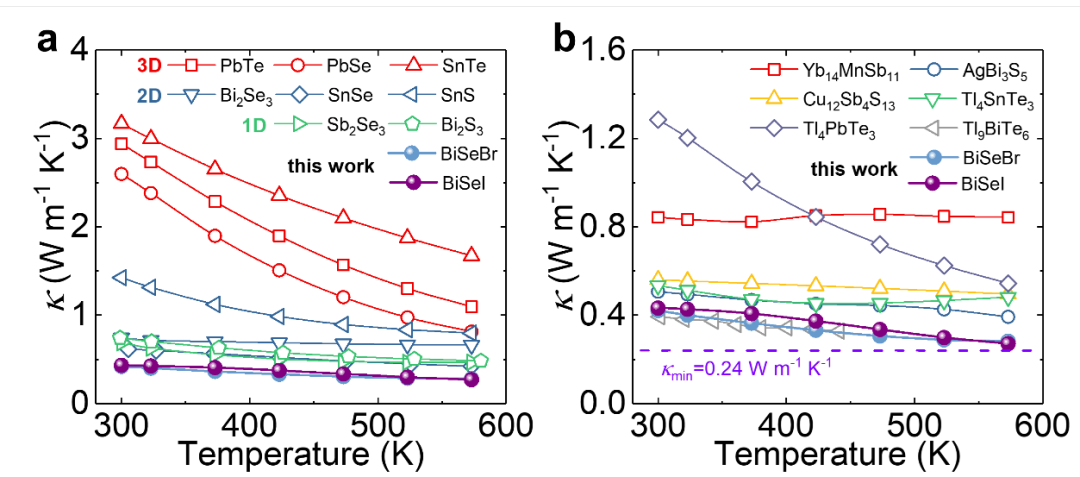Researchers from the team of Prof. Zhao Lidong recently published their latest findings of materials with low thermal conductivity in SCIENCE CHINA Materials, a leading journal of materials co-sponsored by the Chinese Academy of Sciences and the National Natural Science Foundation of China. The research was also reported in the Editor's Choice section of Science.

The research on the cover of SCIENCE CHINA Materials (left) and report of the research in Science.
Titled “Extremely Low Thermal Conductivity from Bismuth Selenohalides with 1D Soft Crystal Structure”, the research discovered a new type of simple one-dimensional (1D) crystal structured bismuth selenohalides (BiSeX, X = Br, I) with extremely low thermal conductivity (Fig. 1). It combined the first-principles calculations, neutron powder-diffraction measurements and temperature tunable aberration-corrected scanning transmission electron microscopy (STEM) to expound on the mechanism of the extremely low thermal conductivity in 1D BiSeX, offering a new approach to the selection of low thermal conductivity materials.

Fig. 1 (a) 1D crystal structured BiSeI. (b) Nanowires in BiSeI revealed by STEM.
Materials with extreme heat transport properties are valuable for thermal management. For example, heat dissipation in electronic communications requires high thermal conductivity, while materials with low thermal conductivity have huge potential in fields like thermal barrier coatings and thermoelectrics. High thermal conductivity often comes with properties like simple crystal structure, low molecular weight, strong chemical bonding and low anharmonicity, and low thermal conductivity usually means the opposite.
In their previous work, the team of Prof. Zhao Lidong found that 2D asymmetrical layered crystal structured materials have strong anharmonicity leading to low thermal conductivity (Nature 508 (2014) 373-377). They also optimized the electrical transport properties on the basis of low thermal conductivity by manipulating complex energy band structures (Science 351 (2016) 141-144, Science 360 (2018) 778-783, Science 365 (2019) 1418-1424). Solving the conflict between thermal and electrical conductivity, they gradually found a research direction of searching for high-efficiency thermoelectric materials among wide bandgap materials and overcame the difficulty that narrow bandgap could limit high thermoelectric performance to a narrow temperature range (Science 367 (2020) 1196-1197).
More recent efforts have been made in picking out materials with low thermal conductivity from wide bandgap materials by reducing the dimensions of crystal structures, using anisotropy to resolve the conflict between thermal and electrical conductivity, and developing new thermoelectric materials. The team discovered high thermal conductivity in 3D cubic-type structures of PbTe, PbSe and SnTe. As the crystal structure dimensionality decreases, the thermal conductivity also declines because of the enhanced phonon scattering. For chain-like 1D BiSeX, the weak ionic bonding of Bi and halogens further reduces the thermal conductivity and forms the soft 1D crystal structure, which means that the chemical bonding along all three crystallographic directions is weak and leads to a quasi-0D crystal structure. This special structure features a thermal conductivity of ~ 0.27 Wm-1K-1. The number is significantly lower than that of the compounds exhibiting intrinsically low thermal conductivity (Fig. 2) and approaches the theoretical minimal thermal conductivity.

Fig. 2 (a) The thermal conductivities of IV-VI compounds show a decreasing trend as the crystal structure dimension decreases from 3D, 2D to 1D, and the soft 1D crystal structure further reduces the thermal conductivity of BiSeBr and BiSeI. (b) The thermal conductivities of BiSeBr and BiSeI are obviously lower than other compounds with low thermal conductivity and approach the theoretical minimal thermal conductivity.
Comparison of 2D slabs in Bi2Se3, 1D chain in Sb2Se3 and 1D chain in BiSeX (Fig. 3) showed that the weak ionic bonding of Bi and halogens leads to stronger anharmonicity, lower phonon velocity and larger atom displacements (proven by neutron powder-diffraction measurements and STEM). Illustrating a new way to find low thermal conductivity among materials with 1D crystal structure, the current research may have wide applications in fields requiring this quality, such as thermal barrier coatings and thermoelectric materials.

Fig. 3 Schematic diagrams and the corresponding crystal structures of (a, d) 2D slabs in Bi2Se3, (b, e) 1D chain in Sb2Se3 and (c, f) 1D chain with migration of halogens in BiSeI and their (j–l) projected electronic localization functions (ELF) along the chain. The isosurface level of ELF is 0.9.
The first authors of the research are Wang Dongyang, who received his PhD in materials science from Beihang University in 2020, and Huang Zhiwei, a post-doctoral fellow in the team of Prof. Zhao Lidong, the corresponding author.
This work was supported by the National Key Research and Development Program of China, the National Natural Science Foundation of China, the National Science Foundation for Distinguished Young Scholars, Beijing Natural Science Foundation, China Postdoctoral Science Foundation Grant, 111 Project, etc.
Reported by the WeChat Official Account of Hangxiaoxuan
Edited by Chen Shuo and Shi Yue
Translated by Li Mingzhu
Moreinformation:
The article (SCIENCE CHINA Materials, 63 (2020) 1759-1768):
http://engine.scichina.com/doi/10.1007/s40843-020-1407-x
Report byScience (Science, 368 (2020) 1325):
https://science.sciencemag.org/content/sci/368/6497/twil.full.pdf
Introduction to Prof. Zhao’s team:
http://shi.buaa.edu.cn/zhaolidong/zh_CN/index.htm

